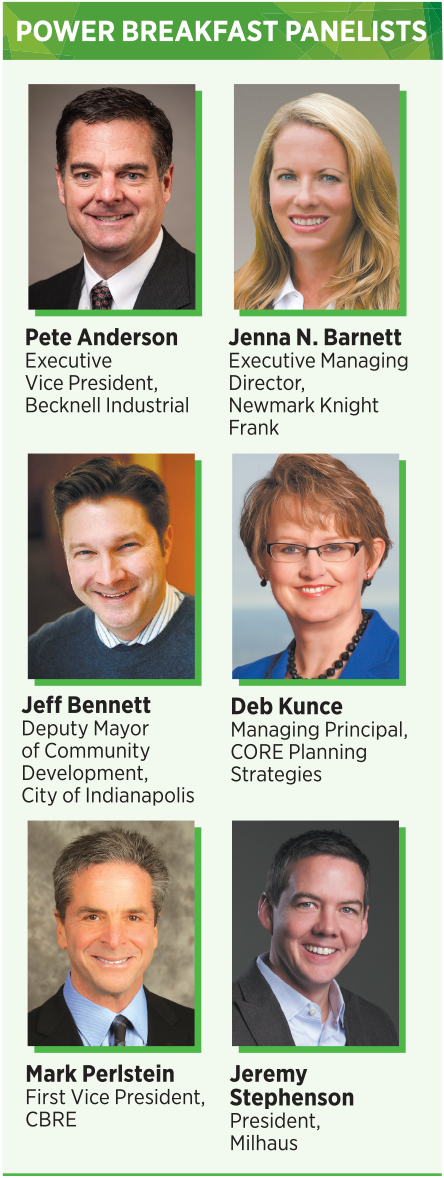Subscriber Benefit
As a subscriber you can listen to articles at work, in the car, or while you work out. Subscribe Now Below are excerpts from the panel discussion at the Sept. 12 Commercial Real Estate Power Breakfast.
Below are excerpts from the panel discussion at the Sept. 12 Commercial Real Estate Power Breakfast.
Jeremy Stephenson: The apartment boom is for a lot of different reasons. …The fundamentals are still pretty good for Indianapolis—I mean supply and demand is keeping in pretty good check. … The rent growth is still projected to be 2-1/2 to 3 percent. Overall, the market’s still really good because the job growth continues to be pretty steady. … And while it may seem like we’re overbuilding, I think it’s more a matter of the market dynamics are just changing around residential. … I think multifamily rental is becoming much more in vogue than it was 10 to 15 years ago as an option for people.
Pete Anderson: E-commerce is actually a very active part of the industrial sector. It takes up about 30 percent of all of the absorption across the nation, and Indianapolis is very well positioned to do our part of that. It has great access to interstates—you can reach 80 percent of the population within a one-day drive—and that’s showing up in the numbers. We continue to project a large part of the absorption in Indianapolis to come from e-commerce. What drives that probably most substantially is the FedEx hub.
Jenna Barnett: I think the tech sector has played a huge role in [the strong downtown office market]. There’s been a lot of success stories come out of Indianapolis, and that’s driven companies that are headquartered elsewhere to open up offices here. There have been a ton of startups here. It’s a very healthy environment. I have several clients that opened a small office here and have chosen to grow here because of our workforce and the cost of real estate. And it just makes sense if you’re in New York and you’re trying to hire customer service related to tech, you can do it much more economically here than you can in New York City.
Jeff Bennett: When I started in community development in the mid ’90s, the end of Mass Ave where the Davlan is … buildings were boarded up. … Twenty years later, Mass Ave is an overnight success, and it’s our jobs collectively to keep pushing that boundary further in each direction. I think Catherine Esselman [of Downtown Indy Inc.] is the one who says that downtown is a state of mind, and we want that state of mind to go as far out from the center of the city as we can.
Deb Kunce: In addition to working with neighborhoods, we also work with a lot of municipalities—cities and towns and primarily through their redevelopment commissions—and we see that they want to attract developers. They want to attract new development to their communities, but they’re realizing that sometimes it’s not financially possible for that to happen if the infrastructure isn’t in place already. And so I think the cities are recognizing proactively that if they invest in that infrastructure—whether that’s utilities, roads, parking—it will allow that development to come a little faster.
Mark Perlstein: The Carson’s space is prime real estate downtown. It would be wonderful if it could be a single retailer like Target. That’s doubtful, obviously, because it’s on three floors, it’s 135,000 feet and each floorplate’s about 45,000 feet. What I envision there potentially would be Simon will probably locate restaurants along Meridian Street and Washington Street. That’s the highest and the best use for the developer to put in.
Bennett: What we heard from the residents who live on the Allisonville corridor or near Binford Boulevard is we want to be reconnected to Castleton, and we also want to prevent the sort of decline of the suburban mall that we've seen across the country and that you've seen here in Indianapolis in the last 20 years. So there will be a focus on a sort of market analysis of what's going on in Castleton, what's vacancy look like, what's occupancy, what's the health of the retail, but then a real look at what the city needs to do using the tools that it has to reconnect and sort of retrofit Castleton, a future Castleton, in such a way that reconnects with neighborhoods and the people can actually get around in ways other than by car.
Perlstein: It’s interesting to note that I think one of the problems with Castleton is that Interstate 465 actually cuts it in half, and if you notice the retailers that tend to do better are the retailers that are located closer to the west side of Castleton.•
Please enable JavaScript to view this content.
